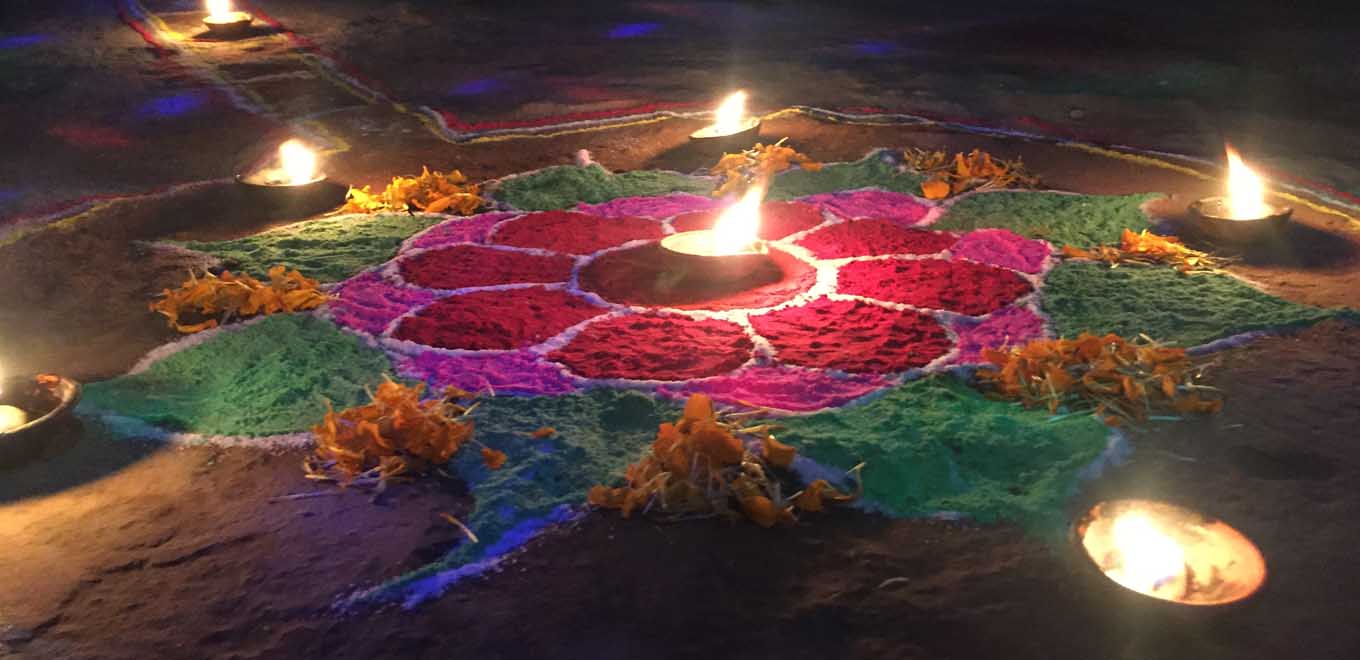
Tihar
Tihar also known as Deepawali and Yamapanchak, is a five day long Hindu festival celebrated primarily in Nepal and some parts of India such as Darjeeling , Sikkim, and Assam. It’s is the Festival of Lights as, diyas are lit inside and outside the houses to make it illuminate at night .
The festival is novel in that it shows reverence to not just the elders and the gods, but also to the animals such as crows,cows, and dogs that have long lived in relationship with humans. People make patterns on the floor of living rooms or courtyards using materials such as colored rice , dry flour , colored sand or flower petals outside their house, called Rangoli, which is meant to be sacred welcoming area for the Gods and Goddesses of Hinduism, mainly Goddess Laxmi.
Tihar Festival is the second biggest festival in Nepal. It’s celebrated for five days and each Tihar holiday has its own saying. The first day of Tihar is to worship crows, “the messenger of death”. The second day of Tihar is to honor dogs, “the guardian for the god of death”. The third day is to welcome the Goddess of Laxmi. The forth day is to thank cows. The fifth day is to place Tihar quotes to brothers and present Tihar gifts for sisters.
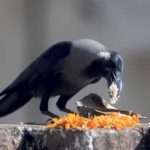
Days-1: Kaag Tihar
The first day of the festival is called Kaag Tihar. They are considered to be nowadays messengers. Crows and ravens are worshiped with offerings of sweets and dishes placed on the roofs of houses. The cawing of crows and ravens symbolize sadness and grief in Hinduism. Devotees believe that the offerings will help stave off grief and death in their homes .
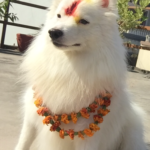 Days-2:Kukur Tihar
Days-2:Kukur Tihar
The second day of Tihar Festival is called as kukur Tihar. On this days, people will honor dogs for the believe that the dog can guarantee the souls of the dead to get to heaven. In this day we celebrate them and cherish their love, protection and the wonderful bond we share with them. The red vermilion, marigold garland symbolizes sacredness.
Days-3/4 : Gobardhan Puja/ Gai Puja
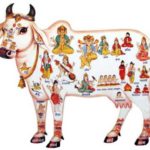 ’Gobar’ means ‘Cowdung’ and ‘Gobardhan’ is the name of mountain that Lord Krishna lifted to protect the villagers from angry king of gods Indra from torrential rain that he caused. Worshiping Gobardhan is believed to have begun from that incident. Another reason is Cowdung is a good source of manure to farmers as well.
’Gobar’ means ‘Cowdung’ and ‘Gobardhan’ is the name of mountain that Lord Krishna lifted to protect the villagers from angry king of gods Indra from torrential rain that he caused. Worshiping Gobardhan is believed to have begun from that incident. Another reason is Cowdung is a good source of manure to farmers as well.
‘Gai Puja’ means ‘Cow Worship’. Cow is represents Laxmi, the goddess of wealth and fortune. Where she is not given proper respect is always prevailed by ‘Daridrata’. So Gai Puja is also known as ‘Laxmi Puja’. Goddess Laxmi is worshipped in the evening. We address cow as ‘Gau Mata’
Laxmi Puja is the most celebrated ‘festival of Light’. Houses are decorated with flashing lights, candles, etc and banana trees are erected in front of all houses. Womens and girls sings ‘Bhailo song’ from house to house. From song it is also clear that this day of celebration is also about ‘Vaaman Avatar’ of Lord Vishnu defeating and blessing King Bali.
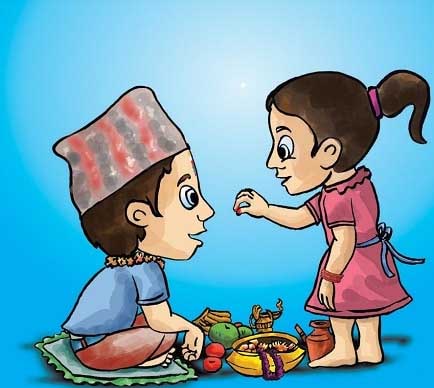 Days-5: Bhai Tika
Days-5: Bhai Tika
Brother sister relationship is emphasized this day. It is believed that Yamraj, the god of death, visited his sister, Goddess Yamuna, on this day during which she applied the auspicious tika on his forehead, garlanded him and fed him special dishes. Together, the ate sweets, talked and enjoyed themselves to their hearts’ content. Upon parting, Yamraj gave the Yamuna a special gift as a token of his affection and , in return, Yamuna gave him a lovely gift which she had made with her own hands. That day Yamraj announced that anyone who receives tilak from his sister will never die on that day. This is also the day when men and boys sing ‘Dheusi song’ house to house.
In addition to these, people make colour ful Ashtamangala mandalas and recite chants and procedures in accordance with Tantric rituals. Along with the seven-coloured tika, sister provide brother with Sagun, sweets,makhamali garland, and a sacred cotton thread of Tantric importance, similar to Janai thread meant to protect their bodies.
Roshani Basnet

